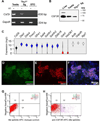Granulocyte colony-stimulating factor prevents loss of spermatogenesis after sterilizing busulfan chemotherapy
- PMID: 25439845
- PMCID: PMC4282609
- DOI: 10.1016/j.fertnstert.2014.09.023
Granulocyte colony-stimulating factor prevents loss of spermatogenesis after sterilizing busulfan chemotherapy
Abstract
Objective: To determine whether granulocyte colony-stimulating factor (G-CSF) could prevent loss of spermatogenesis induced by busulfan chemotherapy via protection of undifferentiated spermatogonia, which might serve as an adjuvant approach to preserving male fertility among cancer patients.
Design: Laboratory animal study.
Setting: University.
Animal(s): Laboratory mice.
Intervention(s): Five-week-old mice were treated with a sterilizing busulfan dose and with 7 days of G-CSF or vehicle treatment and evaluated 10 weeks later (experiment 1) or 24 hours after treatment (experiment 2).
Main outcome measure(s): Experiment 1: testis weights, epididymal sperm counts, testis histology. Experiment 2: PLZF immunofluorescent costaining with apoptotic markers. Molecular analysis of G-CSF receptor expression in undifferentiated spermatogonia.
Result(s): Ten weeks after treatment, busulfan-treated mice that also received treatment with G-CSF exhibited significantly better recovery of spermatogenesis and epididymal sperm counts than animals receiving busulfan alone. G-CSF led to increased numbers of PLZF+ spermatogonia 24 hours after treatment that was not accompanied by changes in apoptosis. To address the cellular target of G-CSF, mRNA for the G-CSF receptor, Csf3r, was found in adult mouse testes and cultured THY1+ (undifferentiated) spermatogonia, and cell-surface localized CSF3R was observed on 3% of cultured THY1+ spermatogonia.
Conclusion(s): These results demonstrate that G-CSF protects spermatogenesis from gonadotoxic insult (busulfan) in rodents, and this may occur via direct action on CSF3R+ undifferentiated spermatogonia. G-CSF treatment might be an effective adjuvant therapy to preserve male fertility in cancer patients receiving sterilizing treatments.
Keywords: Spermatogonial stem cells; cancer therapy; cytokines; fertility preservation; infertility.
Copyright © 2015 American Society for Reproductive Medicine. Published by Elsevier Inc. All rights reserved.
Figures



References
-
- Wallace WH, Anderson RA, Irvine DS. Fertility preservation for young patients with cancer: who is at risk and what can be offered? Lancet Oncol. 2005;6:209–218. - PubMed
-
- Mitchell RT, Saunders PT, Sharpe RM, Kelnar CJ, Wallace WH. Male fertility and strategies for fertility preservation following childhood cancer treatment. Endocr Dev. 2009;15:101–134. - PubMed
-
- Clark AT, Phillips BT, Orwig KE. Fruitful progress to fertility: Male fertility in the test tube. Nat Med. 2011;17:1564–1565. - PubMed
-
- Ries LAG, Melbert D, Krapcho M, Mariotto A, Miller BA, Feuer EJ, et al. SEER Cancer Statistics Review, 1975–2004. Bethesda, MD: National Cancer Institute; 2007.
Publication types
MeSH terms
Substances
Grants and funding
- F32 HD079235/HD/NICHD NIH HHS/United States
- P30CA54174/CA/NCI NIH HHS/United States
- UL1 RR025767/RR/NCRR NIH HHS/United States
- KL2 TR001118/TR/NCATS NIH HHS/United States
- R00HD062687/HD/NICHD NIH HHS/United States
- R00 HD062687/HD/NICHD NIH HHS/United States
- P30 GM092334/GM/NIGMS NIH HHS/United States
- UL1RR025767/RR/NCRR NIH HHS/United States
- R21 HD078916/HD/NICHD NIH HHS/United States
- P30 CA054174/CA/NCI NIH HHS/United States
- UL1 TR001120/TR/NCATS NIH HHS/United States
- R21HD078916/HD/NICHD NIH HHS/United States
LinkOut - more resources
Full Text Sources
Other Literature Sources
Medical
Miscellaneous

